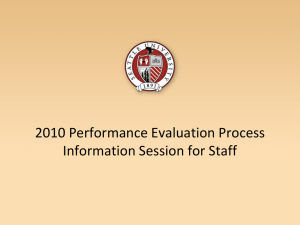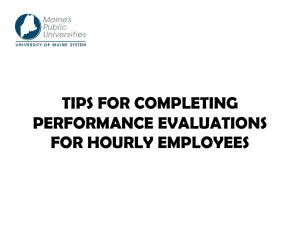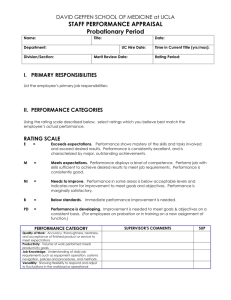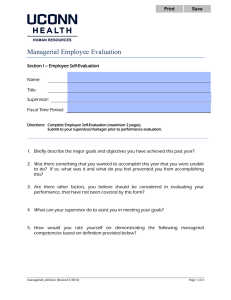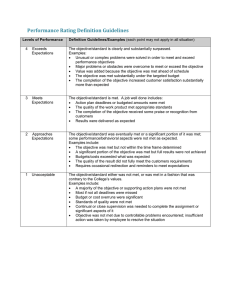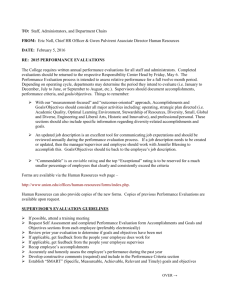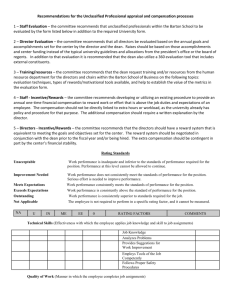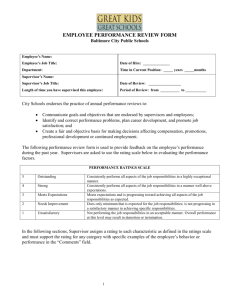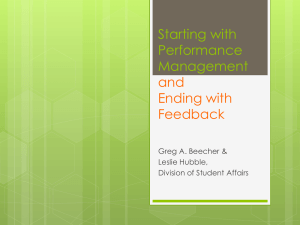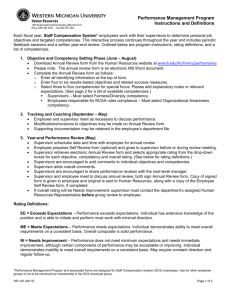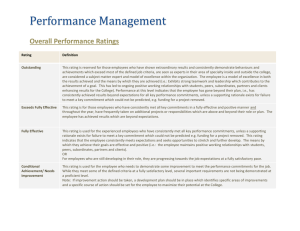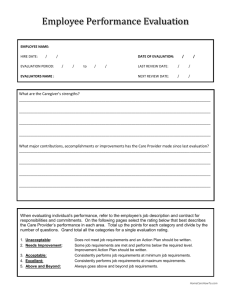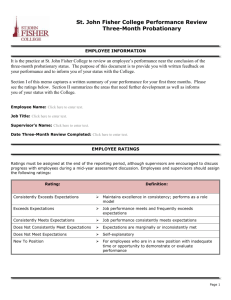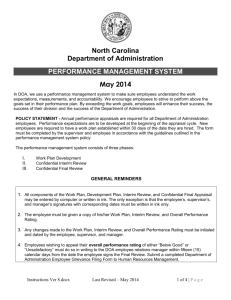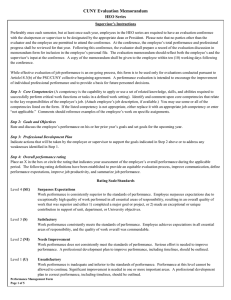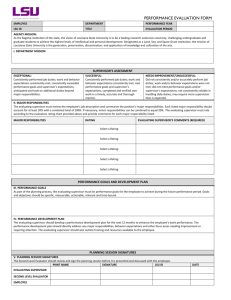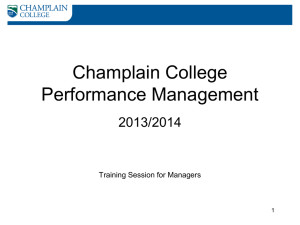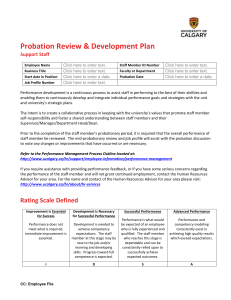Performance Evaluation Overview and Timeline
advertisement
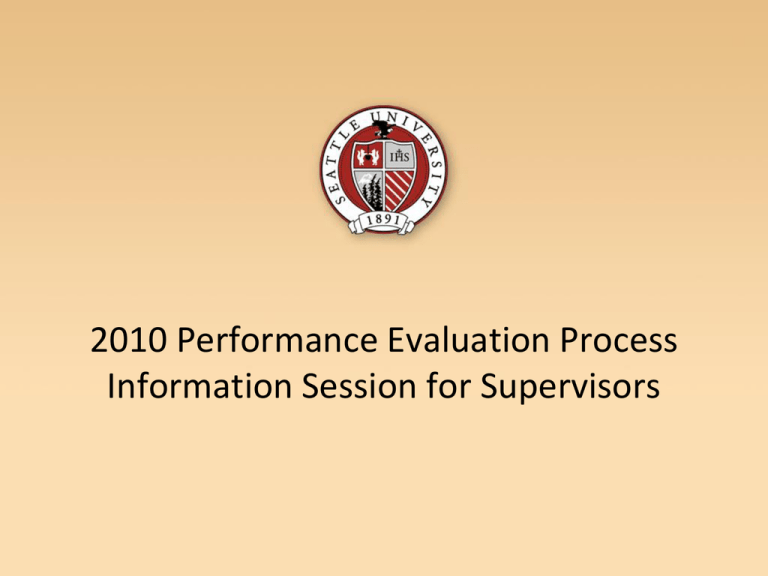
2010 Performance Evaluation Process Information Session for Supervisors Discussion Overview Effective Performance Management Process Components 2009 Performance Evaluation Summary Process Enhancements Results Preparing for 2010 Performance Evaluations Process Enhancements Tools and Tips for Conducting Effective Evaluations Components of an Effective Performance Management Process Connects individual performance to SU’s Mission, Vision, Values and Strategic Initiatives Measures and Recognizes Individual Performance and Contributions Promotes Excellence and Professional Development Connects to Mission, Vision, Values & Strategic Initiatives Job Description Professional Dev. Individual Mission, Vision, Initiatives Policies, Procedures, Expected Competencies Division/Department Mission, Vision and Values Strategic Initiatives Policies, Procedures, Expected Competencies University 2009 Performance Evaluation Summary Enhancements Professional Competencies linked to University Mission, Vision and Values Option of Narrative or Structured Format Overall Rating, expanded to 5-point scale Refined Goals Section Solicited information on Development Needs and, Supervisory Support and Improvement Opportunities 2009 Performance Evaluation Summary Results Overall University Completion Rate = 84% Professional Skill Development Needs Expressed Supervisory Communications Project/Time Management Software/ OIT 2010 Staff Evaluation Process Enhancements Further Refined Rating Definitions Created separate Self-Evaluation and Supervisor Evaluation Forms Addition of Supervisory/Leadership Competency Section The Performance Management and Evaluation Process • 5 Key Performance Management Processes • Performance Evaluation Overview/Timeline • Tips on Preparing Performance Evaluations 5 Key Performance Management Processes Articulation of Expectations: Job Clarification and Goal Alignment Consistent Performance Tracking Check-In Meetings: interim performance conversations Manage Performance Problems as they occur Wrap it all together: The Annual Performance Evaluation Performance Evaluation Overview and Timeline Set date and time for an evaluation meeting Prepare for the meeting, including completion of a performance evaluation form Exchange evaluations forms prior to the meeting date Meet to review and discuss performance and set forth plans for the future Supervisor and employee finalize evaluation forms, and submit to HR by August 31st Preparation: Information Gathering Notes from on-going meetings, assignments, observations, performance discussion reflections during the year Job Description Individual’s Resume Previous Performance Evaluation and projects, goals Feedback from students/customers, co-workers, others Work samples, accomplishment Objective and Valuable Documentation Accurate Objective facts, records, and incidents Time Appropriate Events or incidents should have taken place within the evaluation period Behavioral Address what someone does, rather than his or her thoughts or beliefs Consistent Use similar information and level of detail for each person evaluated Complete Include sufficient details and specific examples to back up conclusions on performance. Writing Do’s and Don’ts Do Describe behaviors Be specific Document observed behaviors Document impact of behavior Don’t Use labels or judgments Be general Rely on hearsay Judge based on personal preference Overall Performance Rating The scale of 1-5 is used with specific definitions for each point on the scale. Consistency between ratings and comments on performance, goals and professional development needs Use whole numbers when rating a specific job performance area or overall performance. Performance Not Acceptable Needs Performance Development 1 2 Performance is Performance meets consistently below most of the job job expectations. requirements but A corrective action requires more than plan has been or is usual supervisor being developed to follow-up and achieve specific direction. results. Employee will Employee’s require additional performance will education and be review again coaching from the according to the supervisor in order corrective action to consistently plan’s objectives meet job and timeline. expectations. Meets Expectations 3 Performance consistently meets and sometimes exceeds job requirements. All critical goals are achieved. Results are consistent with those of a fully trained, highly competent employee. Over the past year has made the expected contributions to the department. Exceeds Expectations 4 Performance consistently meets and frequently exceeds job requirements and established goals. Results frequently exceed competent peers in the same or similar positions. Over the past year has made a significant contribution to the department. Outstanding 5 Performance and demonstrated expertise is consistently at a superior level. Employee achieves outstanding results and models effective behaviors that are an inspiration to others. Over the review period, employee has consistently made exceptional or unique contributions to the department. Rating Pitfalls to Avoid The Halo Effect: Allowing one good aspect of a person’s character or performance to influence the entire evaluation. The Horns Effect: Allowing one negative aspect of a person’s character or performance to influence the entire evaluation. Partial Rating: Basing the rating on the most recent period of time, not the total evaluation period. Similar to me: Evaluating more favorably those who are similar to the rater Favoritism: Evaluating friends higher than other employees. What’s the harm in a bit of “evaluation inflation”? Impacts the person being evaluated: loss of full potential, professional development, motivation Impacts the work group: communicates that people are not held fully accountable or that there is preferential treatment Impacts you as a manager: leadership effectiveness, management decisions Impacts overall performance of work group, department, divisions, the university Goal Setting Goal setting is completed as part of the annual evaluation process. As you review accomplishments and performance for the previous period, you also set goals for coming year. Both the employee and supervisor should agree on the goals. What’s a goal? Specific statements that describe results to be achieved What’s a task? The steps needed to accomplish a goal SMART Goals Specific Results Oriented Measurable Time Bound Achievable Evaluation Meeting Preparation What are the important items you want to discuss at the meeting? Is there one central message or critical point to be addressed? What questions do you have for the meeting? What do you want to get out of this meeting? In what ways will you actively contribute to a meaningful, constructive and productive dialog? At the Evaluation Meeting Make sure the time and place are planned; allow for enough time; no interruptions; a comfortable setting. Be prepared. Know your goals for the meeting, have examples ready. Listen. To have a full picture, you need the other person’s perspective. Be candid—get to the point. Be constructive in feedback The Five Levels of Listening 1. Listening to UNDERSTAND 2. Listening for APPLICATION 3. Listening to TELL MY STORY 4. Listening for JUDGMENT 5. NOT Listening Giving Feedback Constructive Feedback is: descriptive of behavior and impact specific not general directed at behavior that can be changed interactive to ensure clear communication stated in the first person to assign responsibility based on observed behavior balanced Receiving Feedback Breathe! – it helps the body to relax and the brain to focus Listen Actively to understand the other’s perspective Paraphrase and Ask Questions to ensure you are accurately receiving the intended message Take time to absorb what you heard Take responsibility for your actions and behavior Focus on the whole message, not just one or two aspects Wrap Up and Next Steps Review the key points Assure the employee that you want to work together to help continue his or her development Summarize agreed-on actions you will both take – including writing of goals and their due dates Ask the employee to sign the evaluation form Components of an Effective Performance Management Process Connects individual performance to SU’s Mission, Vision, Values and Strategic Initiatives Measures and Recognizes Individual Performance and Contributions Promotes Professional Excellence and Professional Development
